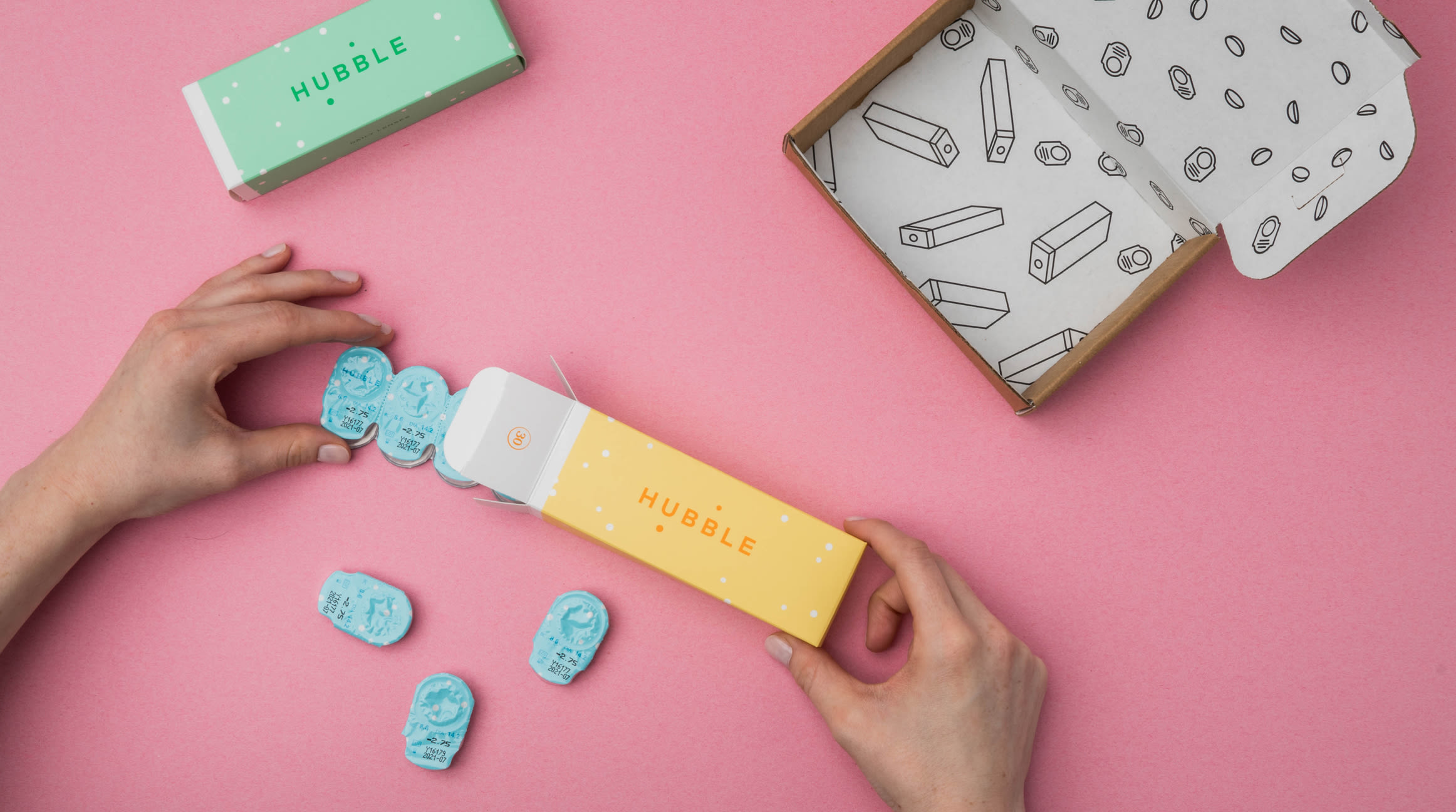Types of Contacts and How They Differ

There’s a lot to consider when choosing the best contact lenses, but determining which type of contacts to go with is often the first step. Different types of contacts come with various benefits of drawbacks—and deciding which to go with will ultimately depend on your individual needs and preferences.
While your eye doctor can provide a recommendation on which type of contacts to go with, knowing how each type differs can be helpful in understanding what you’re getting, and can help open the door for conversations about other options.
Types of Contacts
Contacts come in a variety of materials that can affect performance, comfort, and more. Let’s take a look at the four common types of contact lenses.
Soft Contacts
Soft contact lenses are the most common type of contacts. These lenses are made from flexible, water-based plastics—typically either hydrogel or silicone -hydrogel. These materials allow oxygen to pass through to the cornea which improves comfort and reduces the risk of corneal hypoxia—or a lack of oxygen to the cornea—which can result in symptoms like burning or irritation in the eye.
Because of their enhanced comfort, the original hydrogel soft contacts changed the game when they were first released in 1971. Hydrogel contacts are still fairly common today; however, silicone -hydrogel lenses have taken over as the most common type of contacts today. These lenses, released in 2002, offer increased oxygen flow to the cornea, further improving on some of the benefits introduced with hydrogel lenses. However, greater deposits of debris and protein collect on silicone hydrogel contact lenses than hydrogel lenses, and as a result some patients may prefer the traditional hydrogel materials.
Between hydrogel and silicone -hydrogel lenses, soft contacts make up the large majority of contacts worn today. These lenses work well for new contact wearers because they are fairly easy to adjust to and provide enhanced comfort over other types of contacts.
Rigid Gas Permeable Contacts
Rigid Gas Permeable (RGP) contacts—also known as GP or hard contacts—are made from a silicone-based material and maintain their shape, as opposed to being flexible like soft contacts. Unlike the original hard contacts, RGP lenses, like soft contacts, allow oxygen to pass through to the eye. However, because of their rigidity, RGP contacts are often considered as a less comfortable lens option, especially initially when the wearer is adjusting to them.
That being said, RGP contacts can provide a number of benefits over soft contacts. RGP are generally more durable than soft lenses being that they are far less likely to tear or rip, and they don’t need to be replaced as often—a single pair of RGP lenses can last as long as one year. RGP lenses also often offer sharper, clearer vision than soft lenses, and often are better at correcting astigmatism.
Despite their benefits, RGP aren’t nearly as popular as soft lenses. This is mainly due to the extended adjustment period associated with the lenses. It can take up to weeks for wearers to get used to RGP lenses, and not wearing the lenses for a few days can mean re-adjusting all over again. The lenses also generally cost more—while their durability can make them a cost-effective choice, losing or damaging a pair can be costly.
There are also specialized types of RGP lenses designed for specific situations. For example, Orthokeratology—or Ortho-K—uses modified RGP contacts that change the shape of the cornea to correct vision. Scleral lenses are a type of RGP contacts that cover the sclera, or the white part of the eye, and can help protect the cornea if it has been damaged.
Hybrid Contacts
What if there was a lens with the comfort of soft lenses with the performance of RGP lenses? That’s the goal of hybrid contact lenses. These contacts combine the lens materials, offering a rigid central zone surrounded by a soft outer zone, known as a skirt.
Hybrid contacts have been around for a while, but perfecting this technology has proved difficult. Because of this hybrid lenses are rare being that few options are currently available. In addition to this, hybrid lenses are also more difficult to fit than either soft or RGP lenses.
PMMA Contacts
While RGP contacts are sometimes referred to as hard contacts, they differ from PMMA contacts, the original hard contacts. First introduced in 1948, these hard contacts were made of a hard plastic called polymethyl methacrylate (PMMA). At this time, this represented a major stepping stone for vision correction and lead toward advancements like soft and RGP contacts.
Unlike modern contacts, PMMA lenses aren’t gas-permeable, meaning oxygen can’t flow through them to the eye. Instead, PMMA contacts are fitted to move when the wearer blinks as a way to pull oxygen into the cornea.
Once gas-permeable contact lenses were invented, the use of PMMA lenses dramatically decreased. Today, PMMA lenses are almost never prescribed.
Types of Disposable Contacts
In addition to lens material, contacts also come with different replacement schedules, or when the contacts need to be discarded and replaced with a new pair. Let’s take a look at the three most common.
Daily-wear Contacts
Daily-wear contacts—sometimes called dailies—are designed to be worn for one day and then discarded, meaning a new pair is used each day. This makes them a convenient option as the lenses don’t need to be cleaned and left in contact solution overnight like other types of contacts. This ensures that the lenses are completely fresh each day and can help reduce issues like dry eyes or irritation. When worn correctly, daily contacts can also lower the risk of eye infections or other eye health problems.
That being said, daily contacts are typically very thin and can tear more easily than other types of contacts—however, since the contacts are only worn for one day, they don’t need to be handled as often. Daily contacts also typically cost more than other types of disposable contacts.
Bi-weekly Contacts
Bi-weekly contacts can be worn for up to two weeks, at which point they need to be replaced with a new pair. This means the lenses need to be taken out each night and stored in a contacts case with solution. While this helps to keep the lenses fresh and clean, proteins or other deposits can still build on the lenses over time which can lead to issues like blurriness or irritation. For this reason, it’s also important to change the contacts on schedule, as wearing the lenses for longer than intended can cause issues such as eye infections.
Monthly Contacts
Similar to bi-weekly contacts, monthly contacts need to be cleaned and soaked nightly, but the lenses can last for a month until they need to be replaced. Both bi-weekly and monthly contacts come with the benefits of generally being more durable and more affordable than daily-wear contacts. They also produce less waste, as the lenses aren’t discarded as often. Monthly contacts also can be a good option for those who spend a lot of time traveling or on-the-go, as there’s no need to bring the correct number of contacts along—just your contacts, case, and solution.
That being said, like bi-weekly contacts, monthly contacts can degrade over time and may not perform as well at the end of the month.
Choosing the Right Type of Contacts
When it comes to choosing between the types of contact lenses, each individual situation will determine which type is best. As mentioned, soft contacts are by far the most common type of contacts today thanks to their comfort level, but RGP lenses are often praised for their enhanced performance and long-term value. Daily contacts are an increasingly popular option because of their simplicity and benefits for eye health, while bi-weekly or monthly options can be right for those with busier lifestyles.
That being said, there are also many other considerations when choosing the best pair of contacts, all of which will vary based on your situation. Discussing your options with an eye care professional will help determine which type of contacts best suits your individual needs. This will allow you to make a clear decision and get the best treatment for your vision.
Once it’s time for a new pair of contacts, Hubble can help. With Hubble, you get the benefits of daily-wear contact lenses, the convenience of having your lenses delivered each month, and the peace of mind of knowing you're getting rigorously tested lenses made from materials with a long track record of success—all for as little as $1.
See what people are saying about Hubble contacts online, and get your own box of Hubble contacts online today.


